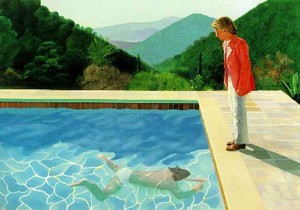
Chuck Close: "Self Portrait" 1980's

David Hockney "Portrait Of An Artist (Poll With Two Figures)" 1973

Vincent Desiderio "The Progress of Self Love" 1990
All are hanging in the MOMA in NYC.
Posted on 08/11/2006 9:19:39 AM PDT by presidio9
The French painter Claude Monet is being used as an environmental monitor, for scientists believe his legendary paintings of the Houses of Parliament can serve as a useful indicator of smog levels in late 19th-century London.
Monet's so-called London series was painted during visits between 1899 and 1905, capturing scenes that are often astonishing for their grey and purplish haze.
Many experts have assumed, though, that this extraordinary effect was an Impressionistic embellishment.
Environmental researchers at the University of Birmingham in central England analyzed nine out of 19 Monet paintings of the Houses of Parliament, painted between 1899 and 1901.
Using the position of the Sun, they calculated the date when the paintings were made, as well as the precise location where Monet set up his easel -- the far end of St. Thomas' Hospital, on the South Bank of the Thames, opposite the British legislature.
The dates and the angle of the Sun concur with Monet's accounts in letters back home to his wife, in which he described his progress on the London series, the weather and other matters, as well as with the daily meteorological records during this period.
The scientists believe there is strong evidence Monet faithfully rendered the London sun as he saw it at the time. In other words, the painter is unlikely to have added artistic touches when back in his studio in France in order to enhance the city's eerie "pea soup" atmosphere.
The next step is to see whether the extraordinary colours captured in Monet's haze give a clue to the chemistry and particles of the pollution.
The study appears in the latest issued Proceedings of the Royal Society A, a journal published by the Royal Society, Britain's de-facto academy of sciences.
In previous research, geometrists have determined the exact date when the US photographer Ansel Adams captured his landscape entitled "Autumn Moon, the High Sierra from Glacier Point" and when Van Gogh made some of his most important night paintings, including "Starry Night."
Smog became a major problem in London by the end of the 19th century, triggered by the burning of coal and particulates from factory chimneys. The phenomenon, celebrated in innumerable books and films, became a worsening health problem until it was curbed by clean-air legislation in the 1950s.
Well, then you can speak with some authority. Although I have taken Art History classes I have no expertise in the subject, but I know B.S. when I smell it. It is obvious to anyone not afraid to be labeled an ignorant hick by the precious elite that the modern art world is largely a personality-driven scam.

Chuck Close: "Self Portrait" 1980's

David Hockney "Portrait Of An Artist (Poll With Two Figures)" 1973

Vincent Desiderio "The Progress of Self Love" 1990
All are hanging in the MOMA in NYC.
Breathtaking!
BTW, I was trying to give a culture crash course, so the next time some knucklehead started putting on airs about modern art you could say "I like some contemporary artists like Chuck Close & Vince Desiderio, but splatter paintings are for kindergarden." I'm afraid I may have failed.
I don't know much about art, but I know what makes me laugh.
You are referring of course, to the controversial Simian School. I think it proves your point about the elitist art community that the Simianists are not widely recognized within the greater community. A hundered years from now, we'll see if that's still the case.
I have several Monet posters at home, as do my adamantly conservative parents. The French are scum (and I'm saying this even though I have French ancestry on both sides of the family), but they do do art well. They also do wine and food well.
Please don't cause this to degenerate into another ugly pro/anti-McGriddles thread.




At the turn of the century, the most common source of heat was coal and wood. As I remember my childhood (when most of the people in town also used coal and wood) we had a layer of smoke and haze over the town from about October until about May.
If Monet was going for a faithful and accurate rendition of how London looked, he could've used fewer impressionist techniques in his painting.
The attempt to glean information about the atmospheric conditions in 19th century London from Monet's paintings is a waste of time. While they're at it, they might as well try to determine the pollution in the Thames from the same imagines.

James Abbott McNeill Whistler The Last of Old Westminster
Disclaimer: Opinions posted on Free Republic are those of the individual posters and do not necessarily represent the opinion of Free Republic or its management. All materials posted herein are protected by copyright law and the exemption for fair use of copyrighted works.